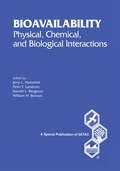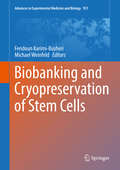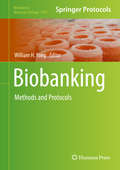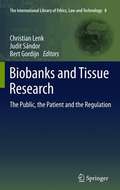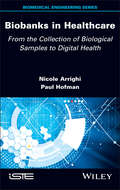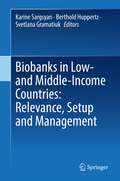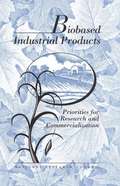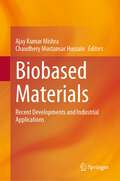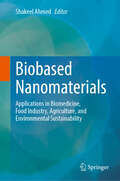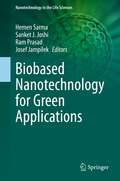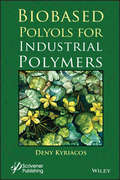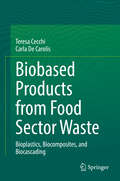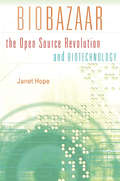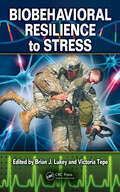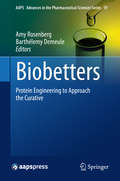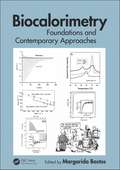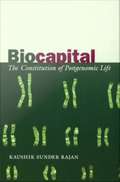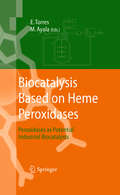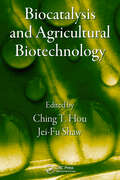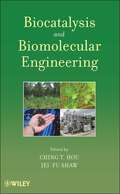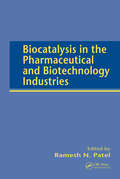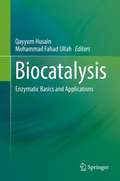- Table View
- List View
Bioavailability: Physical, Chemical, and Biological Interactions
by William H. Benson Jerry Hamelink Peter F. Landrum Harold BergmanPractical and provocative, Bioavailability reviews prevalent understanding of the physical-chemical-biological mechanisms that control the bioavailability of both organic and inorganic contaminants in aquatic environments.Discusses the complex issues that surround many regulatory issues Emphasizes the need to identify and control that portion of the total concentration that is biologically available and can cause adverse effects, i.e., "active" Examines the influence of dynamic factors, such as pH, alkalinity, and light on these mechanisms Addresses the subject of speciation for both organic and inorganic contaminants
Biobanking and Cryopreservation of Stem Cells (Advances in Experimental Medicine and Biology #951)
by Feridoun Karimi-Busheri Michael WeinfeldBiobanking is considered to be one of the ten ideas changing the world with an estimated value of $45 billion by 2025. Despite the challenges, as the climate for innovation in the biobanking industry continues to flourish around the world, it is certain that amazing discoveries will emerge from this large-scale method of preserving and accessing human samples; biobanking is no longer just a place for collecting and storing samples. This book will cover a wide variety of subjects from across the future biobanking spectrum including scientific strategies, personalized medicine, regenerative medicine and stem cell challenges, disease surveillance, population genetics and innovative methods of biobanking.
Biobanking in the 21st Century: Volume I - Techniques (Advances in Experimental Medicine and Biology #864)
by Feridoun Karimi-BusheriBiobanking, an emerging field supported by academia, industry and health administrators alike, is distinctly different today from the practice that once defined it. The science of Biobanking, which initially involved simply storing blood or tissue samples in a freezer, is now a highly sophisticated field of research, and expected to grow exponentially over the next decade or two. This book aims to serve the purpose of further enriching the available literature on Biobanking, by offering unique and more useful collection of ideas for the future. The book outlines the experiences of developing modern Biobanking repositories in different countries, whilst covering specific topics regarding the many aspects of Biobanking. This book will be of interest to a wide range of readers including: academics, students, volunteers and advocates of patients' rights.
Biobanking: Methods And Protocols (Methods in Molecular Biology #1897)
by William H. YongThis volume not only discusses various common biobanking topics, it also delves into less-discussed subjects such as what is needed to start a biobank, training of new biobanking personnel, and ethnic representation in biospecimen research. Other chapters in this book span practical topics including: disaster prevention and recovery; information technology; flora and fauna preservation including zoological fluid specimen photography; surgical and autopsy biobanking; biobanking of bodily fluids; biosafety; cutting frozen sections; immunohistochemistry; nucleic acid extraction; and biospecimen shipping. Written in the highly successful Methods in Molecular Biology series format, chapters include introductions to their respective topics, lists of the necessary materials and reagents, step-by-step, readily reproducible laboratory protocols, and tips on troubleshooting and avoiding known pitfalls.Unique and comprehensive, Biobanking: Methods and Protocols is a valuable resource for novice and practicing biobankers, and for end-user researchers. This book aims to bring new insight into the field and expand on current biomedical biobanking studies.
Biobanks and Tissue Research: The Public, the Patient and the Regulation (The International Library of Ethics, Law and Technology #8)
by Bert Gordijn Judit Sándor Christian LenkThe research field of biobanks and tissue research is highly promising. Many projects around the globe are involved in the collection of human tissue and health data for research purposes. These initiatives are driven by the perspective of decisive breakthroughs in the knowledge of the genetic pathways involved in widespread diseases. However, there are considerable ethical and legal challenges to be considered as well. These challenges encompass the use of body material for research purposes, the misuse of genetic and other health data by third parties, trust in science and medicine, concerns regarding privacy, use of genetic data for forensic applications by the state and the police, and regulatory issues. This volume is divided into three parts: the inclusion of the public, the rights of donors and patients, examples and recommendations for the future of tissue research. It presents a comprehensive overview of the most important topics in the field by renowned scholars in medical ethics and biolaw.
Biobanks in Healthcare: From the Collection of Biological Samples to Digital Health (ISTE Invoiced)
by Paul Hofman Nicole ArrighiBiobanks ensuring the governance and management of biological resources have become essential entities. The development of biotechnologies, the increased prevalence of biological drugs and the identification of biomarkers associated with molecular classifications of tissue lesions make it essential to have organized access to human biological samples, which have become precious and rare. The digital era and the production of massive data that comes with it have rendered biobanks the guarantors of the reproducibility of experiments and of the overall quality of medical research. Biobanks in Healthcare explores the upheaval linked to the massive deployment of digital health and precision medicine. The future of health biology lies in the deployment of biobanks in fields that have yet to be explored, putting them at the forefront of this extraordinary 21st-century research adventure.
Biobanks in Low- and Middle-Income Countries: Relevance, Setup and Management
by Berthold Huppertz Karine Sargsyan Svetlana GramatiukThis book introduces the fundamentals of biobanking and guides through the practical planning thereof, with a special focus on the situation in low- and middle-income countries. On the example of the setup of a Ukrainian biobank the book discusses the main steps and aspects of successful biorepository implementation and management. Topics covered include collection, storage and shipping of samples, establishment of an IT system, development of a sustainability plan, and project and risk management. Furthermore, the importance of the formation of international biobanking societies such as the Ukraine Association of Biobanks is highlighted, and their main objectives and tasks are discussed.The book addresses life science and business professionals as well as national authorities who are interested in biobanking in general and in setting up a biobank in particular.
Biobased Industrial Products: Priorities for Research and Commercialization
by National Research CouncilPetroleum-based industrial products have gradually replaced products derived from biological materials. However, biologically based products are making a comeback--because of a threefold increase in farm productivity and new technologies.Biobased Industrial Products envisions a biobased industrial future, where starch will be used to make biopolymers and vegetable oils will become a routine component in lubricants and detergents.Biobased Industrial Products overviews the U.S. land resources available for agricultural production, summarizes plant materials currently produced, and describes prospects for increasing varieties and yields.The committee discusses the concept of the biorefinery and outlines proven and potential thermal, mechanical, and chemical technologies for conversion of natural resources to industrial applications.The committee also illustrates the developmental dynamics of biobased products through existing examples, as well as products still on the drawing board, and it identifies priorities for research and development.
Biobased Materials: Recent Developments and Industrial Applications
by Ajay Kumar Mishra Chaudhery Mustansar HussainThis book discusses the extraction, purification, modification, and processing of biobased materials and their various industrial applications, across biomedical, pharmaceutical, construction, and other industries. It includes contributions from experts on hybrid biopolymers and bio-composites, bioactive and biodegradable materials, bio-inert polymers, natural polymers and composites, and metallic natural materials. Therefore, this encyclopedia is a useful reference for scientists, academicians, research scholars, and technologists. Major challenges of biobased materials are their efficient development, cost-effective, and green & environment friendly production/applications. This encyclopedia answers these challenges to professionals and scientists for proper utilization of biobased materials. It presents the recent practices of biobased materials technology in different scientific and engineering domains. It helps the bounded industrial outcomes to reach the general readership of different domains. This encyclopedia bridges the technological gaps between the industrial and academic professionals and the novice young students/scholars. The interdisciplinarity of this encyclopedia makes it unique for a wide readership. The topic of biobased materials is currently popular in the scientific community, working in such following areas as Recycled materials, Renewable materials, Materials for efficiency, Materials for waste treatment, Materials for reduction of environmental load, Materials for easy disposal or recycle, Hazardous free materials, Materials for reducing human health impact, Materials for energy efficiency, Materials for green energy, etc. This is a relatively hot topic in materials science and has strong demands for energy, material and money savings, as well as heavy contamination problems, despite that the area of biobased materials belongs to most important fields of modern science & technology, no important encyclopedias have been published in the area of “biobased materials”
Biobased Nanomaterials: Applications in Biomedicine, Food Industry, Agriculture, and Environmental Sustainability
by Shakeel AhmedThis book comprehensively covers various aspects of biobased nanomaterials, including their types, fabrication methods, characterization techniques, and applications in different fields. The book starts with an introduction to biobased nanomaterials, highlighting their significance in various fields due to their unique properties. The first few chapters cover the different types of biobased nanomaterials, their properties, and how they are extracted from various natural sources. The methods of fabrication of biobased nanomaterials are discussed in detail, including the techniques for controlling their size, shape, and composition. It then delves into the characterization of biobased nanomaterials, discussing the different techniques used to determine their properties, including their morphology, size, structure, and composition. The subsequent chapters explore the various applications of biobased nanomaterials in different fields such as environmental applications, wound healing, tissue engineering, food industry, agriculture, sensing technology, biomedical applications, and energy storage devices. The advantages of biobased nanomaterials over traditional nanomaterials are highlighted, including their biodegradability and sustainability. The environmental concerns associated with biobased nanomaterials, as well as the health and safety concerns, are also discussed. The book concludes by looking at the prospects of biobased nanomaterials and how they can contribute to sustainable development. Overall, the book is an informative and comprehensive book that provides a thorough understanding of biobased nanomaterials and their various applications. It is a valuable resource for researchers, students, and professionals in various fields such as materials science, chemistry, biology, and environmental science. alike.
Biobased Nanotechnology for Green Applications (Nanotechnology in the Life Sciences)
by Ram Prasad Hemen Sarma Sanket J. Joshi Josef JampilekInvestigation on biobased nanomaterials has provided new insights into the rapidly advancing fields of the biomedical and environmental sciences by showing how these nanomaterials are effective in biomedicine and environmental remediation. These particles hold tremendous prospective applications, and are likely to become the next generation of particles in these areas. As such, research is ongoing and the data generated should have the potential for a sustainable future in both the environmental and biomedical fields.This book presents important findings on the role of and identification of novel applications of biobased nanomaterials. Unlike other books in this field, this book focuses entirely on sustainable application and remediation in biomedicine and environmental science. The chapters are written in such a way as to make them accessible to the reader, and furthermore, the volume can be readily adopted as a reference, or used as a guide for further research.This project was based on recent research (the last 5 years) and developed through an extensive literature search. The editors have also compiled some advanced, outstanding texts that should be of benefit to graduate students in their research.
Biobased Packaging Materials: Sustainable Alternative to Conventional Packaging Materials
by Shakeel AhmedThis book provides a comprehensive and authoritative review of recent developments in bio-based packaging materials along with an array of their industrial applications. It offers an interdisciplinary approach, combining food engineering, polymer science, materials science, and sustainable aspects of bio-based materials with their synthesis, properties, characterization, and applications in packaging materials. The book encloses chapters covering fundamental concepts, manufacturing, properties, characterization, and interaction of bio-based materials. It also discusses topics related to the different usage of bio-based materials, their environmental impact, regulations, safety aspects, circular economy, challenges, and opportunities allied to bio-based materials. It is an essential resource for academicians, researchers, students, and professionals interested in exploring the potential bio-based materials in food packaging.
Biobased Polyols for Industrial Polymers
by Deny KyriacosThe replacement of polyols synthesized from petrochemical by polyols originating from natural products, notably from vegetable oils and animal fats, has been the subject of research projects for a number of decades. Very recently, however, the polymers industry has intensified its efforts to include the “green products”, such as biobased polyols, in applications already available in the market. Examples of such applications include polyurethane foams, elastomers and epoxides. This book describes the extraction of the natural constituents of several fruits and plants as well as their chemical conversion to polyols. In addition to the chemistry involved in the process, particular emphasis is attributed to their applications.
Biobased Products from Food Sector Waste: Bioplastics, Biocomposites, and Biocascading
by Teresa Cecchi Carla De CarolisAn increased demand for waste upcycling has prompted the food industry to become more efficient in its handling of waste. Efficient utilization of food waste is of concern to consumers, environmentalists, and policy makers. In the past, food waste has been used for the production of bio-gas and bio-fuels, fertilizers and animal feed. Biobased products from food sector waste: Bioplastics, biocomposites, and biocascading proposes an innovative use of food waste—as filler in a bioplastic matrix.The upcycling of food industry waste to produce new composites has a number of beneficial features, including (i) avoiding the cost of waste disposal; (ii) reducing bio-based composites price; (iii) avoiding using edible resources as a starting material for bio-based composites (to eliminate competition between biomass use for food, feed, and material use); (iv) producing a non-food bio-based output different from existing outputs (bio-fuels or bio-energy). The production of value-added items supports the development of a circular and sustainable economy in a thriving bio-based sector via the emergence of food value chains.The authors explore the safety of bio-based products. Using an evidence-based approach, they detail the volatile profile of biobased products and underline the absence of priority air pollutants released by fossil plastics, which pose a significant public health threat. The volume also delves into socioeconomic considerations and environmental concerns related to the upcycling of food by-products. Finally, the authors address how advances in digital technology can make food waste upcycling a negative-cost process.
Biobazaar: The Open Source Revolution and Biotechnology
by Janet HopeFighting disease, combating hunger, preserving the balance of life on Earth: the future of biotechnological innovation may well be the future of our planet itself. And yet the vexed state of intellectual property law—a proliferation of ever more complex rights governing research and development—is complicating this future. At a similar point in the development of information technology, “open source” software revolutionized the field, simultaneously encouraging innovation and transforming markets. The question that Janet Hope explores in Biobazaar is: can the open source approach do for biotechnology what it has done for information technology? Her book is the first sustained and systematic inquiry into the application of open source principles to the life sciences. The appeal of the open source approach—famously likened to a “bazaar,” in contrast to the more traditional “cathedral” style of technology development—lies in its safeguarding of community access to proprietary tools without discouraging valuable commercial participation. Traversing disciplinary boundaries, Hope presents a careful analysis of intellectual property-related challenges confronting the biotechnology industry and then paints a detailed picture of “open source biotechnology” as a possible solution. With insights drawn from interviews with Nobel Prize–winning scientists and leaders of the free and open source software movement—as well as company executives, international policymakers, licensing experts, and industry analysts—her book suggests that open source biotechnology is both desirable and broadly feasible—and, in many ways, merely awaiting its moment.
Biobehavioral Resilience to Stress
by Victoria Tepe Brian J. LukeyMilitary service involves exposure to multiple sources of chronic, acute, and potentially traumatic stress, especially during deployment and combat. Notoriously variable, the effects of stress can be subtle to severe, immediate or delayed, impairing individual and group readiness, operational performance, and ultimately‘survival. A comprehensive co
Biobetters: Protein Engineering to Approach the Curative (AAPS Advances in the Pharmaceutical Sciences Series #19)
by Amy Rosenberg Barthélemy Demeule"Biobetters: Protein Engineering to Approach the Curative" discusses the optimization of protein therapeutic products for treatment of human diseases. It is based on the fact that though numerous important therapeutic protein products have been developed for life threatening and chronic diseases that possess acceptable safety and efficacy profiles, these products have generally not been reexamined and modified for an improved clinical performance, with enhancements both to safety and efficacy profiles. Advances in protein engineering, coupled with greatly enhanced understanding of critical product quality attributes for efficacy and safety, make it possible to optimize predecessor products for clinical performance, thereby enhancing patient quality of life and with the potential for great savings in health care costs. Yet despite such knowledge, there is little movement towards such modifications. This book examines engineering protein therapeutic products such that they exhibit an optimal, not just an adequate, clinical performance profile. Two product classes, therapeutic enzymes for lysosomal storage diseases (enzyme replacement therapies, ERT) and monoclonal antibodies (mAbs), are used as examples of what modifications to such proteins could be made to enhance clinical performance, "closer to a cure" as it were. For ERT, the key to optimizing clinical performance is to ensure the ERT is endowed with moieties that target the protein to the relevant target tissue. Thus, for Gaucher Disease, our best example of how to optimize an ERT to address a disease that manifests in specific target tissues (macrophages and monocytes), the enzyme has been extensively modified to target macrophages. For diseases such as Pompe Disease, largely a disorder of muscle, optimal performance of ERT will depend on endowing the enzyme with the ability to be taken up via the Mannose 6 Phosphate Receptor, and so one of the chapters in the book will discuss such approaches. Moreover, a major failure of biotechnology based products is to gain access to the CNS, a key target tissue in numerous diseases. Thus, a chapter has been devoted to strategies to access the CNS. Additionally, immune responses to therapeutic proteins can be highly problematic, eliminating the efficacy of life saving or highly effective protein therapeutics. This is especially poignant in the case of Pompe Disease wherein great improvement in muscle strength and functionality is lost following development of an immune response to the ERT with consequent patient deterioration and death. Thus, a chapter regarding protein engineering, as well as other non-clinical approaches to diminishing immunogenicity is a valuable part of the book. Monoclonal antibodies (mAbs) can be engineered to bind targets relevant to a wide variety of diseases; binding affinity, however, is only part of the equation and one of the chapters will present a molecular assessment approach that balances affinity with pharmacokinetics and manufacturability. As with other proteins immunogenicity can be problematic, being responsible for loss of efficacy of anti-TNF mAbs, often after prolonged successful treatment. The authors will also share their perspective on the consequences of physico-chemical modifications occurring to mAbs once they reach the circulation or their target, a research area open to further development from a protein engineering as well as analytical perspective. This book will also discuss novel platforms for protein therapeutics, technologies that exceed mAbs with respect to potency, and hence, potentially efficacy. These platforms consist largely of repeat domain proteins with very high affinity for their target ligands, but while potentially more efficacious, immunogenicity may be a major problem limiting use. The economics surrounding the issue of biobetters is another high-profile issue - this final chapter will explore the incentives and disincentives for developing biobetters and consider incentives that might make their pursuit more rewarding.
Biocalorimetry: Foundations and Contemporary Approaches
by Margarida BastosConnecting past, present, and future instrument development and use, Biocalorimetry: Foundations and Contemporary Approaches explores biocalorimetry's history, fundamentals, methodologies, and applications. Some of the most prominent calorimeter developers and users share invaluable personal accounts of discovery, discussing innovative techniques a
Biocapital: The Constitution of Postgenomic Life
by Kaushik Sunder RajanBiocapital is a major theoretical contribution to science studies and political economy. Grounding his analysis in a multi-sited ethnography of genomic research and drug development marketplaces in the United States and India, Kaushik Sunder Rajan argues that contemporary biotechnologies such as genomics can only be understood in relation to the economic markets within which they emerge. Sunder Rajan conducted fieldwork in biotechnology labs and in small start-up companies in the United States (mostly in the San Francisco Bay area) and India (mainly in New Delhi, Hyderabad, and Bombay) over a five-year period spanning 1999 to 2004. He draws on his research with scientists, entrepreneurs, venture capitalists, and policymakers to compare drug development in the two countries, examining the practices and goals of research, the financing mechanisms, the relevant government regulations, and the hype and marketing surrounding promising new technologies. In the process, he illuminates the global flow of ideas, information, capital, and people connected to biotech initiatives. Sunder Rajan's ethnography informs his theoretically sophisticated inquiry into how the contemporary world is shaped by the marriage of biotechnology and market forces, by what he calls technoscientific capitalism. Bringing Marxian theories of value into conversation with Foucaultian notions of biopolitics, he traces how the life sciences came to be significant producers of both economic and epistemic value in the late twentieth century and early twenty-first.
Biocatalysis Based on Heme Peroxidases: Peroxidases as Potential Industrial Biocatalysts
by Eduardo Torres Marcela AyalaThis monograph describes many applications of peroxidase-based biocatalysis in the biotechnology industry. The need for such a book emerges from the considerable amount of new data regarding the phylogeny, reaction mechanisms, thermodynamic characterization and structural features of fungal and plant heme peroxidases that has been generated in the past 10 years, since the last specialized book on peroxidases was published. The aim of this book is to present recent advances on such basic aspects as evolution, structure-function relation and catalytic mechanism as well as applied aspects, such as bioreactor and protein engineering, to provide the tools for rational design of enhanced biocatalysts and biocatalytic processes.
Biocatalysis and Agricultural Biotechnology
by Ching T. Hou Jei-Fu ShawWorldwide energy and food crises are spotlighting the importance of bio-based products - an area many are calling on for solutions to these shortages. Biocatalysis and Agricultural Biotechnology encapsulates the cutting-edge advances in the field with contributions from more than 50 international experts comprising sectors of academia, industry, an
Biocatalysis and Biomolecular Engineering
by Ching T. Hou Jei-Fu ShawAn expert overview of new technologies guiding the construction of a sustainable society This compendium of important insights from sixty distinguished international scholars looks at the significant advances in progressive environmental technology—especially the molecular engineering used on plants, animals, and microorganisms—as the game changer in the high-stakes race to reverse earth-damaging practices. Biocatalysis and Biomolecular Engineering covers subject matter on the latest developments in eco-friendly and energy-saving manufacturing processes with the emphasis on agricultural technology and bio-based products. Focusing its study on remedies that show promise in curing food and energy ills, this book examines groundbreaking work in various fields, such as nutraceuticals, genetic engineering of agricultural products, and bioenergy. Biocatalysis and Biomolecular Engineering: Can be used as a reference by teachers, graduate students, and industrial scientists who conduct research in bioscience and biotechnology Serves as the first book to bring together fundamentals and leading-edge technologies for the development of bio-based industrial products through biocatalysis; for example, it discusses the preparation of biofunctional micro- and nanoparticles Contains chapters by international experts from academia, industry, and government research institutes Biocatalysis and Biomolecular Engineering builds a cohesive, well thought out case for nurturing new discoveries in eco-technology by inviting critical discussion on devising viable solutions to sustaining the future wellness of humankind.
Biocatalysis for Practitioners: Techniques, Reactions and Applications
by Gonzalo De Gonzalo Iván LavanderaThis reference book originates from the interdisciplinary research cooperation between academia and industry. In three distinct parts, latest results from basic research on stable enzymes are explained and brought into context with possible industrial applications. Downstream processing technology as well as biocatalytic and biotechnological production processes from global players display the enormous potential of biocatalysts. Application of "extreme" reaction conditions (i.e. unconventional, such as high temperature, pressure, and pH value) - biocatalysts are normally used within a well defined process window - leads to novel synthetic effects. Both novel enzyme systems and the synthetic routes in which they can be applied are made accessible to the reader. In addition, the complementary innovative process technology under unconventional conditions is highlighted by latest examples from biotech industry.
Biocatalysis in the Pharmaceutical and Biotechnology Industries
by Ramesh N. PatelBecause enzyme-catalyzed reactions exhibit higher enantioselectivity, regioselectivity, substrate specificity, and stability, they require mild conditions to react while prompting higher reaction efficiency and product yields. Biocatalysis in the Pharmaceutical and Biotechnology Industries examines the use of catalysts to produce fine chemic
Biocatalysis: Enzymatic Basics and Applications
by Mohammad Fahad Ullah Qayyum HusainThis book introduces readers to industrially important enzymes and discusses in detail their structures and functions, as well as their manifold applications. Due to their selective biocatalytic capabilities, enzymes are used in a broad range of industries and processes. The book highlights selected enzymes and their applications in agriculture, food processing and discoloration, as well as their role in biomedicine. In turn, it discusses biochemical engineering strategies such as enzyme immobilization, metabolic engineering, and cross-linkage of enzyme aggregates, and critically weighs their pros and cons. Offering a wealth of information, and stimulating further research by presenting new concepts on enzymatic catalytic functions in basic and applied contexts, the book represents a valuable asset for researchers from academia and industry who are engaged in biochemical engineering, microbiology and biotechnology.
